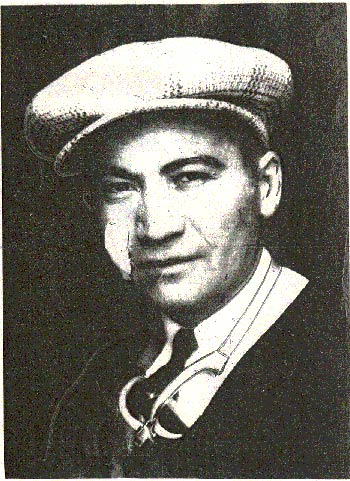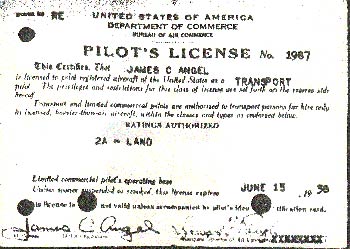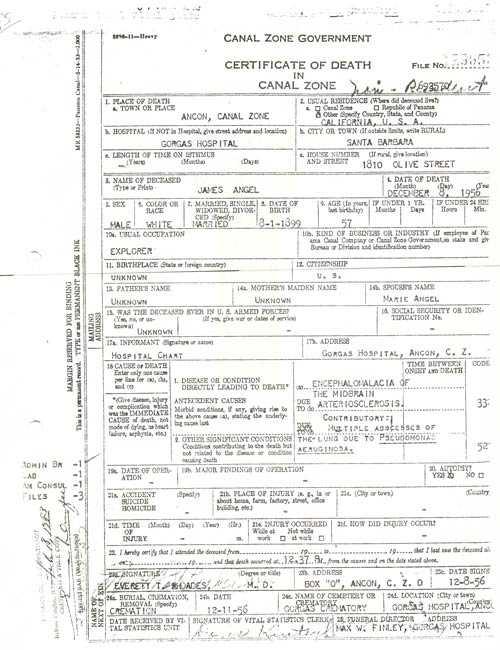|
Jimmie Angel landed at the Davis-Monthan Airfield on April
10, 1930. He was solo in a C-3B Stearman, NC8813.
His home base was identified as New York, and his itinerary
was eastbound from Los Angeles, CA to New York.
He is best known for landing a Flamingo aircraft (NC9487, not a Register airplane), on October
9, 1937, at the top of Ayuantepui (or Ayuan Tepui, I've seen it spelled both ways) in southeastern Venezuela.
This large table mountain had not been charted or explored
before. It has a waterfall (a "mile
high" according
to Angel) tumbling
from its edge. It was later measured to be 3,212 feet. It
was named "Angel Falls" for its discoverer.
Ayuantepui and the falls were the subjects of scientific
expeditions in the late 1930s and then after WWII. The expeditions
resulted in publications in various scholarly journals.
Angel served as a (non-military) transport pilot mostly
in Central America during WWII.
His niece (cited, left sidebar) prepared a lecture about him
in 2001 entitled, "The Truth About Jimmie Angel and Angel
Falls". The text of the lecture, given in support of her
Jimmie Angel Historical Project, and including an image of
Jimmie's family and his Flamingo aircraft, is available to
read here.
There
is little else to add about his life and adventures, except
the following items which do not appear on his niece's site.
First, I found these documents in his dossier maintained at the
National Air & Space Museum, Washington, DC. At right is a copy of his
transport pilot license No. 1987. This June 15, 1938 renewal
replaced the one he probably carried with him to Ayuantepui.
Secondly, this download will
get you a bibliography of books, periodicals and newspapers
on the subject of Jimmie Angel and his activities. This bibliography, as well as the portrait above, comes from his biographical files at the Smithsonian (left sidebar).
Bakersfield Californian, July 21, 1927 (Source: Gerow)
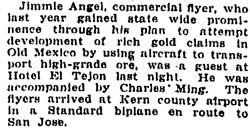 |
This brief filler article, left, from the Bakersfield Californian of July 21, 1927 is an early indicator of the adventurous life he led. The article is courtesy of Mike Gerow.
Jimmie Angel flew West on December 8, 1956 in the Panama Canal
Zone. Below is a copy of the death certificate issued by
the Canal Zone Government. His address, 1810 Olive St.,
now sits a couple of blocks northeast of US101, the El Camino
Real, in Santa Barbara, CA.
If you want to learn more about Pseudomonas infection,
click the link (nobody
said we can't work a little bacteriology into an aviation
history site!)
The following rich image is shared with us by dmairfield.org friend Tim Kalina. It illustrates the prelude to a refueled endurance flight. This image is unique, as it includes the photojournalist's notes on the back (next image). This airplane is a Zenith Z-12 Albatross. According to Russ Plehinger the registration number is NX3622 (not in the Davis-Monthan Register, but see below). Sponsored by the Gilmore Oil Co., this crew attempted their record on December 15, 1930 over Glendale, CA. They took off at 4:16PM, but were forced down for an unidentified reason and the attempt was unsuccessful.
Sneakers for 99 Cents, Saratogan (NY), May 22, 1930 (Source: Link)
 |
Another image of this airplane is at aerofiles, and another in Plehinger, page 101. Significantly, we find Angel landing at the Grand Central Air Terminal with NX3622 on December 15, 1930, the afternoon of his intended endurance flight.
Regardless of the outcome of their record attempt, this image is fascinating to review with a 10X loupe. Judging from the grime on some of their trousers and jackets, being around large, trimotored aircraft wasn't a clean place to be. On the very sharp original you can see pens and pencils in pockets, wrist watches, and dinged knuckles. Angel (far right), besides a parachute, wears a ring on his left pinky. Note the Golden Age gym shoes with knickers and argyle socks on the gentleman third from right. Compare the advertisement at right from the Saratogan (NY), May 22, 1930. The designers of this airplane seem to have done everything possible to increase parasitic drag.
Jimmie Angel, Far Right, December 13, 1930 (Source: Kalina)
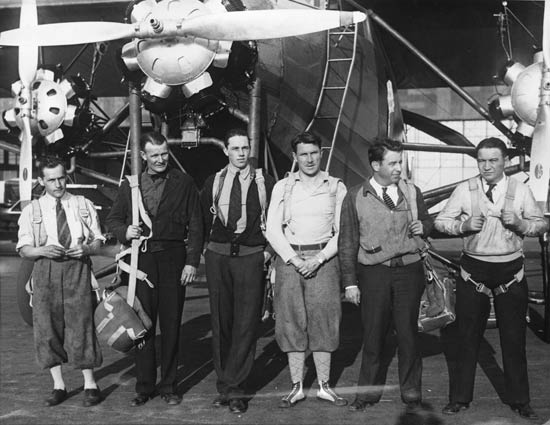 |
Note also, above, coming from the upper cylinders of the outboard engines there are what appear to be gages plumbed and attached to a vertical engine mount strut (you can see the round face of the gage on the starboard engine, just below the horizontal blade of the nose propeller). These may be oil pressure or cylinder head temperature gages that would be visible to the pilot and co-pilot from the cockpit. Hopefully they are wired temperature gages, and, because if the straight lines are copper oil temperature tubes they are prone to failure from vibration fatigue. Properly rigged, they would have a loop or two in the tubing to absorb vibration.
Below, the photojournalist's credit sheet glued to the back of the image above. The flight attempt was made two days after the photo was taken. A site visitor states that Bob Perlick was a Glendale, CA sky writer. He participated in the 1938 Bendix Air Derby. Does anyone KNOW anything about the other four?
Photograph Group Data, December 13, 1930 (Source: Kalina)
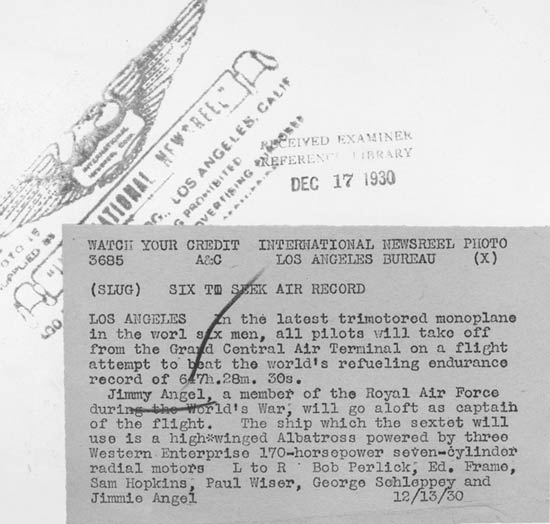 |
Finally, in Jimmie Angel's NASM dossier I found this 21-page
manuscript written by Clifford Esby Angel, Jimmie's younger
brother (see an image of him as a child on his niece's site,
referenced above). This manuscript is undated. See his niece's comment about the manuscript in the left sidebar.
You will find
some "discrepancies" between the information contained
in Clifford's manuscript, versus the well-researched lecture
developed by Jimmie's niece on her Web site, linked above. Comparing their
information gives us an example of the wonderful juxtaposition
of history and lore. Caveat emptor.
---o0o---
That said, as of December 8, 2008, I add this additional information shared with us by a site visitor Rodolfo Lucca from Venezuela. He recommends this link (deactivated because inop by your Webmaster) to a Venezuelan history Web site that provides for us a first-hand account of the landing of Jimmie Angel's Flamingo at Ayuantepui. The account was narrated by Gustavo "Cabuya" Heny, who accompanied Angel on the flight and subsequent hard landing on top of the plateau. Besides the link and background information, Mr. Lucca shares with us images in addition to those at the link. His images are exhibited after the text box, below. The relationship of this information and our donor is as follows. The donor's father, Roberto J. Lucca, MD was a pilot and knew Mr. Heny.
Our donor says, "I found the pictures in my father´s papers [his father died in 1986].... He had the pictures because his little brother, Enrique (still alive, 89 years old) was a very good friend and neighbor of Gustavo (Cabuya) Heny, who was in that flight of August 9, 1937. He was [the one] who took the pictures and told the tale. Mr. Heny was a very healthy young man when that happened. He was an adventurer, some kind of Indiana Jones in those days (Cabuya is a nick name and it means 'rope' in English). Everybody called him 'Cabuya' Heny. The aircraft was or still is a Ryan Flamingo. It was rescued from the top of the Auyantepuy about 20 years ago and placed in a small square at Ciudad Bolivar in Venezuela [see picture, below.... Even more interesting is that, if you go to Google Earth, zoom to "Ciudad Bolivar, Venezuela", look for the airport "X" runways, and right on the north-middle section of it, just in front of the terminal, between some trees, you can actually see Jimmie Angel´s Ryan Flamingo still there! ... the water fall that has his name is the tallest water fall ... 979 meters of free fall (3211 feet).
"I remember when I was a kid, 7 years old, my father did a home film in Kodachrome 16 mm format which included this story. That is reason why the pictures were between his papers. Obviously he got them from his brother Enrique."
Further, he says, "My uncle, Enrique Lucca, also a pilot, was a very close friend of Gustavo "Cabuya" Heny and he is the one who collected the narrative from Mr. Heny. Mr. Heny was on the airplane that day with Mr. Angel. He took all the pictures of the landing site and he was the one who told the narrative.... this text was originated by Mr. Heny's narrations of the facts to my uncle Enrique Lucca. Later the text was corrected and edited by a journalist named Prospero Navarro Sotillo, in order to be publicized in an article [in a] local magazine called LINEAS (lines) edition No.156, April 1970, pages 10 to 16."
The text at the link, above, is in Spanish, but contains striking images by Mr. Heny of the airplane as it sat after landing on top of the plateau. Below, a Google Language translation of the text for English-speaking visitors. This text does not include the images, which you can compare at the link (it might be helpful to open the link in a separate window and place it next to this one). Please NOTE, what follows in the box is a machine translation that gives you a flavor of the narration, but it's not perfect translated prose by any means. The original magazine article consistently misspells Angel's first name. It should be "Jimmie" throughout.
Translated via Google Language From Lineas, No. 156, April, 1970, pp.10-16
An eyewitness account:
Jimmy Angel Landing on El AUYANTEPUY 33 Years Later
Lineas regarded as a privilege to offer its readers a paper chart the landing of the famous American pilot Jimmy Angel on the plateau of Auyantepuy, and an account of his companion on the issue Gustavo Heny feat that shocked the world 33 years ago.
We can not fail to mention our gratitude to Mr. Enrique Lucca Escobar, the electricity of Caracas, who retained for many years negatives of the photographs we publish today, with proper authorization from its author, Gustavo Heny, and illustrating the story.
The facts have been told to Enrique Lucca by the companion Jimmy Angel, and the journalistic version has been in charge of Prospero Navarro Sotillo.
When jubilant celebrating 50 years of our Air Force National, we believe that the documents offer in this issue come to join the great history of the conquerors of infinite spaces.
All these photos dating from 1937. The "palms Llanera" Kamarata-out of curiosity, see Lineas, March 70. I do not see the crown of Auyantepuy, as in Figure left only the water jets and the fog of Angel Falls. .
A Witness ...
It dates back to the origin of the 1920 landing of the plane Jimmy Angel in the highlands of Auyantepuy, some 17 years later. Exactly occurred on October 9, 1937.
Background
In 1920 while made a flight demonstration by South americas, Jimmy Angel was seen to make a precise landing on an alti-Planicie Andean (3,500 meters high) Eleben to breakage of cuplón of magneto. The seasoned American pilot made a piece with the sole of one of his shoes, and so was able to take off and continue its flight without interruption. He had come to Panama-Jimmy Angel-your flight demonstration, and found in a hotel bar, where the then discussed the fact of that emergency landing, when a man approached him U.S., with a planito in hand . What is wanted? The intended to lead to the aviator who brought a place south of the Orinoco River in Venezuela, where it was necessary landing and takeoff similar to the already-mentioned above-but at 2,600 meters high. Jimmy was not very interested, because just returned from a long journey, and trying to get rid of that individual, he said yes, but he demanded for his services, the sum of five thousand U.S. dollars ... in a cheque for management of a bank in Panama, before making the flight, By doing so, not Jimmy told him no, but demanded a fee too high. And, indeed, considered this amount as difficult to fulfill, by the person who made the proposition. Which would not surprise Jimmy Angel, when at 10 o'clock in the morning the next day received a visit from strange character with a check for $ 5,000 required.
Man of speech, Jimmy made the necessary arrangements, and as previously established, he moved to Venezuela with his passenger, entering our territory to the south, beyond the Orinoco River ...
Relative to JIMMY
According to the narrated by Jimmy years later, he ignored the exact site, and was guided by the odd adventurer, who told him to a river whose hand was landing. Jimmy did so: it landed on a small savannah, and reminded him that the time was not very good and it rained a lot. This is extremely concerned whenever one of the wings of the plane, he penetrated plenty of water and earned a knife to puncture the fabric and bailed. A mid-afternoon and stayed the night there, time spent by the passenger to carry out an exploration to a place nearby, bringing with them some 60 pounds of gold nuggets inside bags that surely had prepared in advance while waiting for an opportunity propitious, as the present.
Where is this gold?
It seems that the U.S., accompanied by another, had made an expedition from Peru, to Ciudad Bolivar, where he completed his adventure, but before making the trip successful, the other died from the bite of a snake. It is assumed that they had left this treasure in a safe place in order to collect it at the earliest opportunity. And that made men led by Jimmy ignored until the region ... The next morning, Angel and his passenger took off bound for Panama, where he arrived without any setback, to Jimmy did not mean that nothing strange journey, leaving one more, without paying more attention to cargo transported, Why? An American company was producing a larger aircraft and he only dreamed a pilot and prove it ...
Years later
Coincidentally, Jimmy and another American were found on a train, and the remembrance acknowledged that travel south of the Orinoco ... was already 14 years. It was during the conversation that the adventurer asked if Jimmy had been made millionaire, because it meant that he had returned to the place where, according to him, was a gold flower land. Such an assertion in Jimmy Angel produced a change in its activities, deciding mix two very different emotions to a desire to return to Venezuela: the pleasure of flying and adventure into the material, in view of a possible El Dorado. . .
Since then-years from 1934 to 1935 - Jimmy and his wife Mary, invested their savings in search of that site, and favored negotiation of purchase and sale of aircraft because it was the Flamingo, which would use in future flights and to which baptized with the name "Rio Caroní"
Flights of exploration and discovery of Angel Falls
Angel performed countless flights on their own, in one of them and leading to a companion of Technical Sergeant surname Garcia, while overflying the hill Auyantepuy, which was the region that attracted more Jimmy, noted for the first time the fall Water that today bears his name: Angel Falls, and being impressed by his height. This discovery Jimmy was commented upon his return, and the magnitude of the jump, was corroborated by other people, including Mr Shorty Martin, geologist and surveyor who was doing surveys and explorations in this area, and who had done great friend of Jimmy , Whom he met at Camp Kamarata in the same state of Bolivar. Shorty and Jimmy decided to lift a map of Auyantepuy and to this end, over the edge of the hill making annotations according to the direction, speed and height. For the altimeter of the aircraft felt that the jump was almost 1,000 meters high, which made it the largest in the world. This was confirmed years later by an expedition, to be accurately measured.
Why is it called "Angel Falls"?
The name carries today-Angel Falls-emerged during a meeting held in Caracas, and culminating with the landing of Jimmy at the top of Auyantepuy. At that meeting, besides Jimmy And Shorty, was Gustavo Heny-whom today we have this recount-because he had been interested in the project. When speaking of the fall or jump, Heny-he-was asked what name, keeping both Jimmy and Shorty--not knowing what to answer, then there was a map of the region, and they had not lifted since name. It was Heny who suggested the name of Angel, using the name of Jimmy, its discoverer and those who give themselves known.
Landing in the Auyantepuy
This new group, including Gustavo Heny and Miguel Delgado, moved in the company of Jimmy and his wife Mary, south of Auyantepuy. In a savanna, where Angel used to landing, was lifted a camp they serve as base of operations, since Jimmy insisted that in this hill or very close to him, was the much-sought site. Flights and more reconnaissance flights, and research on land provided by Heny and Delgado, continuing relentlessly, Gustavo climbed the plateau of Auyantepuy twice, increasingly entering into place that Jimmy seemed now recognize, but it was not can reach him by the difficulty of lowering a farallón of about 1,200 feet high plateau which divides the Auyantepuy. At the savannah and see even if their formation was equal to the other, arrived at the conviction of not having with the site. Why? The terrain was extremely mild, mostly covered by layers plants, not yet settled, and among the ferns that grew and nuances "in the form of Mogote", which had to tread necessarily entail sinking knee-deep in mud.
When Heny fell from the second exploration, in which spent 15 days trip, he received a surprise: Jimmy had returned from a flight to Ciudad Bolivar and, with aircraft loaded with Bastimentos, had overflown the plateau and made a touch wheeled satisfied having found firm ground. Only the expected return of Gustavo informing him that and proceed immediately to carry out the planned landing Gustavo Heny, to meet the new, tried to dissuade Jimmy start of the flight immediately, and he called for a reasonable period of waiting for about 12 days In order to climb again on foot and demarcate the landing site, But Jimmy Angel replied that he knew landing sites rather than Gustavo well, everything was fine and it was time to clear the long-awaited mystery of the site, whose search took about three years and their savings were invested entirely ...
Nevertheless, the insistence of Heny achieved its purpose, but only a matter of hours, and agreed starting the next day in the morning. At that crucial moment the clock marked 2 pm of October 8, 1937, and load the plane will take some time. Was it logical anything? Among Gustavo and Jimmy there was unlimited confidence in what everyone had taken under their responsibility, and then Jimmy told him: I am sure that I can land and that if something happens ... you bring to camp. Gustavo, for his part, hoped the skill of the pilot risky. That apparently reduced the risks of adventure ... It lighten the plane for anything that was not essential, including gasoline, of which only left in the tanks enough for round-trip flights would not take more than a quarter of an hour in each direction, will put a shop campaign, a roll Rope of 80-meters long and enough food for 15 days, this time, in a letter to his brother in Caracas, Gustavo had estimated for any eventuality. Since a month ago had been considering a landing in the Auyantepuy.
According to indications of Jimmy placed the greatest weight to the tail, including for each passenger. So the distribution went to Gustavo in the last seat, and then Michael, Mary and Jimmy ...
The dawn of October 9, 1937
He clarified on October 9, 1937 and everything was ready. The takeoff was conducted smoothly at 11 and 20 am, arriving after 15 minutes at a plateau, which over a few minutes prior to landing, I could not hide the emotion that embargaba daring to present before the great unknown Poso smoothly in the Auyantepuy. Jimmy Tan was willing to carry out that once the plane aligned with the runway and alleged that the ground looked propitious, cut engine, magnets, and all switchs were written off, the die was cast ... The "Flamingo" meekly began to rub the surface with its three-wheeled into position for a perfect landing three points-and leaving a footprint with their rubbers between Mogote grass, but increasingly deep as decreasing the speed and wing lost its lift. All bore an eloquent silence until he heard a voice. It was the Gustavo Heny, who from the bottom of the cabin shouted: Pull-out Jimmy ... Pull-out ...
The warning coincided with a small leap of the plane before falling into a softer ground yet, and this locked its front and inertia lifted the tail to sink the nose until the motor shaft and being in that position, as if it read: Auyantepuy, before you pay me ... It was 11:45 a.m.
Inside the cabin there was some confusion because it broke the "security belt" by Gustavo Heny that was Rope or cabuya. His body -1.90 meter- passed between Michael and Mary, going to fall on Jimmy astride where, with the steering wheel and instrument panel were uncomfortably hindrance,
At Jimmy, Maria and Miguel jumped from the aircraft, while he and Gustavo leaving virtually crawling-by-puertecita front because, although with little gasoline, it was leaked by one of the wings that served as support in the plane so uncomfortable position. Fortunately there was no fire on the plane because of the precautions taken by Jimmy, and apart from the shock at the accident happen, the four passengers were unharmed. Constater this, his first task was to straighten the plane using the rope used, and what tied to its tail and threw it.
The preliminary examination of the vessel revealed the rupture of a pipe radiator and engine oil in a small abolladura the left wing, which would have been easy to repair. Where to lay the greatest difficulty, and was not among its possibilities, was making the plane the hook because he was seated on the fuselage with its landing gear completely buried in the soft surface.
The camp SILENT AND A Great Disappointment
At the appointed time with the camp, were initiated calls through the radio equipment of the plane, but unfortunately not received any response, then was repeated at every opportunity and scheduled time for contacts. And the same bad luck that on other occasions ... It was precisely between calls and calls when Jimmy Angel suffered the biggest disappointment; moved to the riverbank, which he was instead of landing in 1920. And found his mistake to notice the difference of an appraisal done from the air and the harsh reality of doing so on land. It was not the site! This, of course, a great sorrow in the group, but the temple of those not yielded expeditionaries face of adversity and, immediately, was spent on planning the fall.
In the wings of the plane, were written with cloth and glue, the words "all ok" (all good), and with an arrow that indicated the course would continue. Jimmy also left a note on the plane, with time and result of landing, as well as the roster of members of the passage as well, would be left aboard the aircraft and luggage not essential to avoid hindrance in the fall.
People from air, land people ...
For Jimmy, a man over land and air, Mary, being a woman, were assigned packages smaller and lighter, while Gustavo Miguel and carried the backpack and the Rope. By Clara on October 10, 1937 would be on its way. So, the next day. Before being exhausted last resort: the attempt to make contact with the camp! At dusk, a note negligible came to alter the mood of that group: a fox with their puppies. So what was little visited-even by other animals-that the fox not resisted, and became aggressive when Henry took into his hands to two of these puppies. With these went up for a while and shared their first meal.
The next morning, and already depleted battery after the plane failed radio contacts, the group began its trek toward the Farallones, which would have to climb and then atraversarlo in order to pass on the other side. This was the concern of the expedition, then was where Gustavo was arrested for 15 days and had been returned by failing to find a way to download it from the side which now needed to climb.
The march was slow because they had to go by opening clubs, sometimes by large helechales, others by ramazones locked, and others to wade rivers. There were days when they could barely move about 150 meters, and on one occasion, because that upon reaching the shore of one of the rivers crossing the plateau, they realized that it was very deep and could only be crossed one kills for felling make a kind of bridge. Another day, the vegetation was so dense ferns, that poor Mary came out with his face scratched and swollen due to rubbing of the leaves.
Despite the slow walk at times, to reach out to clear earned time, and were soon in front of the mole quartzite, full of cracks, and to be up and down. After failed attempts a1gunos found a crack that they facilitated the passage and with the help of the Rope, our four characters went successfully on the other side. Already in this place, the situation changed favourably since the terrain was familiar to Gustavo and everything was reduced to a good hike, although it was not easy, at least was already trite by one of them. Knowing that the time invested in reaching the camp, part of the provisions were left on the road to lighten the march. Once they reached the edge of the hill, sighted the camp and a plane that arrived, which Jimmy said, was to be piloted by Joshua Lopez Henriquez, who had promised to visit in those days. Precisely preparations were made-with the arrival of Joshua-for reconnaissance flights in order to locate the passengers lost when they were presented, by their own means, to the camp. Mistakenly se cree que all arrived in poor physical condition. But it did not. The forecasts made before the flight enabled them to carry out the exhausting return. 11 days had passed since takeoff ...
Above, on the hill, where the plane was a historic monument "Caroní River," inseparable companion of Jimmy, and as an irrefutable fact of the boldness and fearlessness of the pilot and his companions. As he had promised to Jimmy, to review the entire plateau, Gustavo returned to the place where he had left the plane in order to bring any belongings left, including the aircraft film and photography. Incidentally, the film taken began to pass from hand to hand today and his whereabouts remain unknown. Not-so pictures that illustrate this story-have also been provided, as is the narration of the facts by Mr. Gustavo Heny.
Epilogue to an odyssey
After the ordeal, Jimmy spent some difficulties in Venezuela and, sorry, withdrew to live in Panama, where he died in 1956. It was his last wish that his ashes were brought to Venezuela and scattered over the region, which brought so many adventures and who always kept a deep remembrance. Their wishes were met. Mary, and his son Gustavo, a simple but moving ceremony, spread from a plane and on the Angel Falls, the contents of that chest that as a diaphanous cloud, was embraced at Salto, and with him forever regó land that both Jimmy loved ...
|
Below are the additional images(besides those in the original article linked above) shared by Mr. Lucca that he found among his father's papers. Jimmie Angel and the Flamingo are on the right.
According to site visitor Charles Brewer-Carias, this image was taken on October 8, 1937, just before departure to the falls. The people are Kamaracoto (Pemon). At left is Miguel Delgado. At center is Capt. Felix Cardona, a partner of Angel's, who did not go on the flight, and who did not help with the recovery after the crash the next day. He became estranged from Heny and Angel after that.
Jimmie Angel (R) With Unidentified People, October 8, 1937
(Source: Lucca)
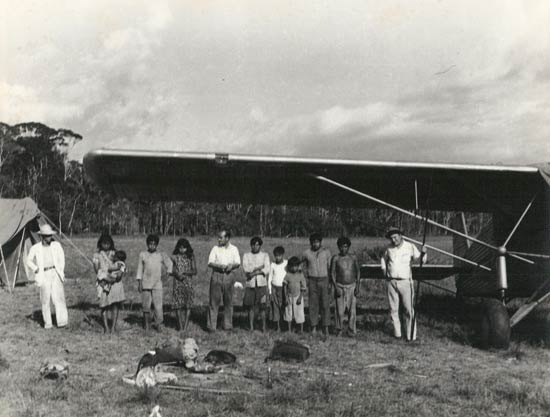 |
Below, is not an image of Angel Falls ("Kerepakupai Merú") photographed from the Flamingo NC9487, it is “Churún merú”. Falling 1,312 feet (400 meters), it is one of the many falls that exit the border of the same plateau. For interest, compare the wheel strut fairings with those in the images above and below.
The question is, who took this image. From this print, it looks like it was taken from the cockpit window, and could have been snapped by Angel unless he was flying from the right seat. However, as sometimes happens with these old photos, where the photo finisher in the dark room has no real information about right-hand or left-hand, this image might be printed backwards.
“Churún-merú” Photographed From Flamingo NC9487, October 9, 1937 (Source: Lucca)
 |
The logic is this.
Modern, Color Image of Churún-merú (Source: Lucca)
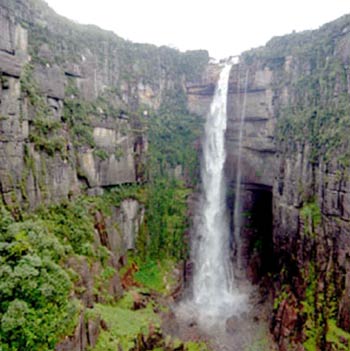 |
The photo at left was taken with color film circa 2008. In this modern photograph of Churún-merú, notice the small fall to the right of the main fall. Now note the position of the small fall in the black & white image above.
“Churún-merú” Photograph Flipped Horizontally, October 9, 1937 (Source: Lucca)
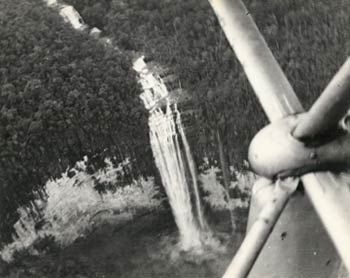 |
Now, compare this with the same black & white image flipped horizontally in PhotoShop. This now orients left and right correctly between the two photos.. The important finding here is that the photo was probably taken by whoever was sitting in the copilot seat, Gustavo Heny or Angel's wife Maria.
We may never be sure of the orientation of the 1937 image, but comparison with modern water flow across nearly 80 years gives us confidence that it was printed backwards.
Below, a sketch map of the plateau showing the relative positions of Angel Falls, the landing site of NC9487 and Churún merú”.
Sketched Map of Falls' Positions vs. the Landing of NC9487 (Source: Lucca)
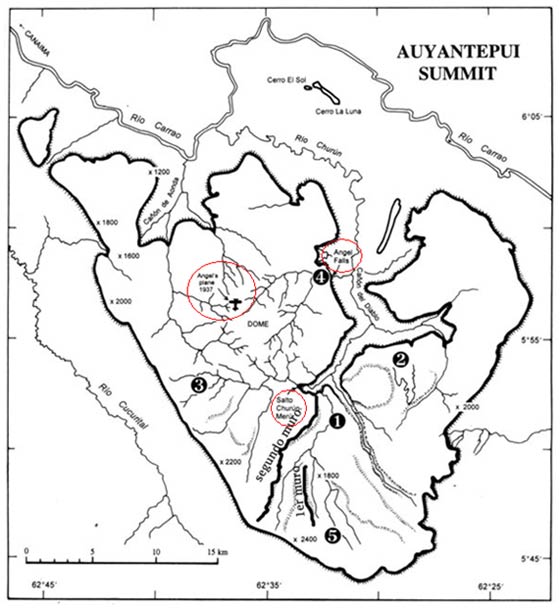 |
Below, the airplane after landing, tail in air, rope over tailwheel, Angel lighting a cigarette, Maria on haunches in background, Miguel Delgado excavating engine cowl from the soft earth. This photo was taken during the days after the landing, after the walk out and back.
NC9487 Nose Up with Rope on Tailwheel, October 9, 1937 (Source: Lucca)
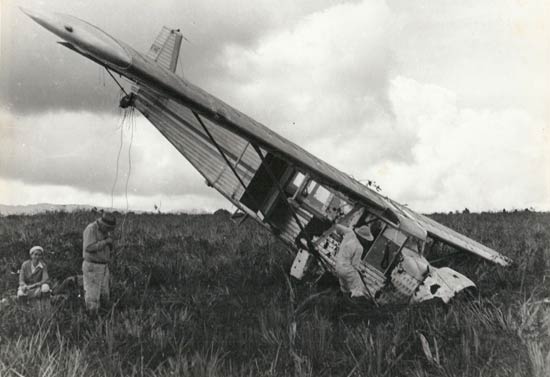 |
Below, a close up of NC9487 after the hard landing atop Ayuantepui October 9, 1937. According to Sr. Brewer-Carais, the man digging out the landing gear is Miguel Delgado, a gardner who worked with Gustavo Heny in Caracas. The photograph was taken by Sr. Heny.
Flamingo NC9487 Nosed Over, October 9, 1937
(Source: Lucca)
 |
Below, after pulling the rope to lower the tail.
Flamingo With Tail Lowered to Level, October 9, 1937
(Source: Lucca)
 |
Below, another view of the leveled Flamingo with tent pitched in the background. They must have anticipated a landing from which they might not be able to take off. They were prepared for that emergency, as well as prepared for the walk out (see link images for their route of travel off the plateau).
Another View of the Straightened Flamingo, October 9, 1937
(Source: Lucca)
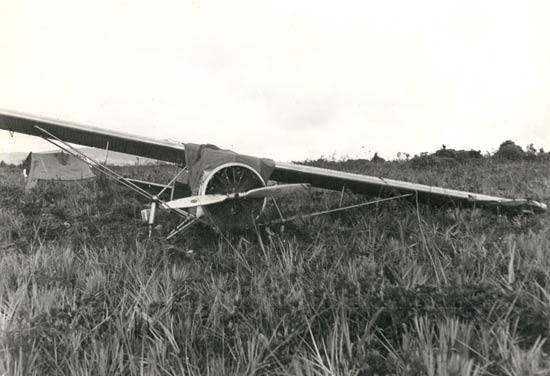 |
Below, another view of the damaged Flamingo. If the ground was harder and the landing gear was OK, they might have been able to get this airplane off the ground despite the damage to the left wing tip.
A Third View of the Leveled Flamingo, October 9, 1937
(Source: Lucca)
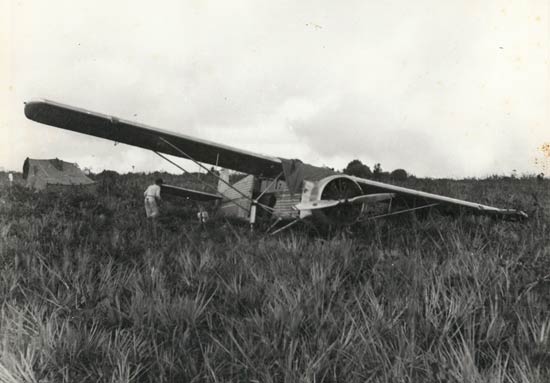 |
When the Angel party walked off of Auyantepui, Jimmie left a note in the airplane. A facsimile of the note was found at the link (it's image number 448). I include a copy of it below, as I am not sure of the longevity of the source.
Intention Note Left by Angel Party, October, 1937 (Source: Web)
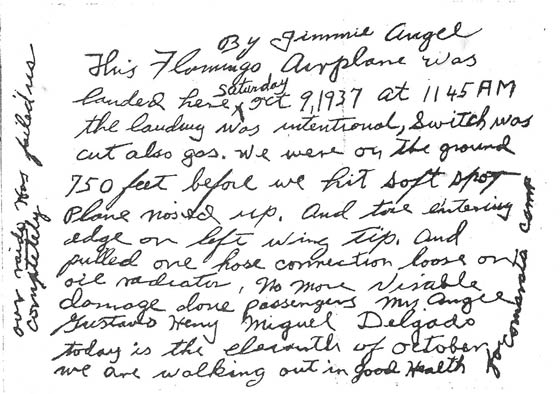 |
I have to admit that my antenna went up when I saw this note written in English. Why would he leave a note in English in the middle of Venezuela? However, I asked Jimmie's niece Karen Angel (cited, left sidebar) about the note.
She states, "Yes, this is a true copy of the note written by James “Jimmie” Crawford Angel (1899-1956) which he left in his Flamingo (NC-9487) airplane El Rio Caroni when he, his wife Marie Angel, Gustavo Heny, and Miguel Angel Delgado commenced their trek 11 October 1937 from Auyántepui. Jimmie Angel was an American citizen born in the state of Missouri. His spoken and written language was English. He spoke Spanish well enough to converse with people. I have never seen any examples of him writing in Spanish. The note was removed in 1956 from the airplane by Aleksandrs (Alexander) Laime (1911-1994), a highly regarded explorer from Latvia who lived in the Auyántepui region for many years. Laime is considered to be the first person to reach the base of Angel Falls by foot. He was the guide for Ruth Robertson’s 1949 Expedition to measure the height of Angel Falls."
Some years later, below, the Flamingo after recovery from the plateau in 1970 and placed on exhibit. About four years earlier, NC9487 made appearances at Peterson Field flown by John H. Cordner, and even earlier at the Parks Airport flown by its manufacturer, Thomas Halpin, and one other pilot.
Flamingo NC9487 on Exhibit Today
at Ciudad Bolivar
(Source: Lucca)
 |
---o0o---
Dossier 2.1.37
UPLOADED: 02/14/06 REVISED: 01/16/08, 12/08/08, 02/22/09, 02/10/10, 12/13/10, 07/09/13, 03/05/17, 12/15/21, 01/06/23
|


